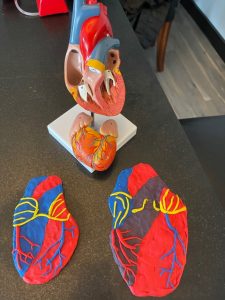https://media.uaf.edu/media/t/1_ktuew8u9

My steam project is on valvular heart disease. I describe the pathway of blood through the heart and circulatory system and diseases of heart valves that affect this blood flow. This picture shows a healthy non-diseased heart next to an enlarged heart with a leaky pulmonary valve. The link above is how to access a video I recorded to describe both hearts.

Hi Olivia! You did an awesome job on your video presentation and the clay models between a normal heart and an enlarged heart with a leaking pulmonary valve. I enjoyed reading your essay as well, the flow was great and you explained everything. I was able to learn about heart valve disease and the effect it has on the heart. You start off by explaining how a healthy heart works and all the components. Oxygenated blood is delivered to the cells and tissues throughout the body in the closed circulatory system. The deoxygenated blood is pumped back to the heart so that it can be oxygenated again and continue the cycle. There are four chambers in the heart. The left and right atria and the left and right ventricles. The ventricles are the pumping mechanism of the heart. The valves of the heart control the direction of the heart flow with an open and close motion. The four heart valves prevent the back flow of blood into the atria. Then you go into heart valve disease and the effect it has on the heart. Heart valve disease is when one or more of the heart valves fails to open or close properly. There can be numerous causes for a heart valve failure from birth defects to natural wear and tear coming from age. Some treatments for heart valve disease can be open heart surgery by replacing the valve with mechanical or biological valves or just repairing the old valve to make it function again. Some less invasive treatments can include diuretics to reduce inflammation, blood thinners to prevent blood clots, and antiarrythmics to prevent an irregular or rapid heartbeat.